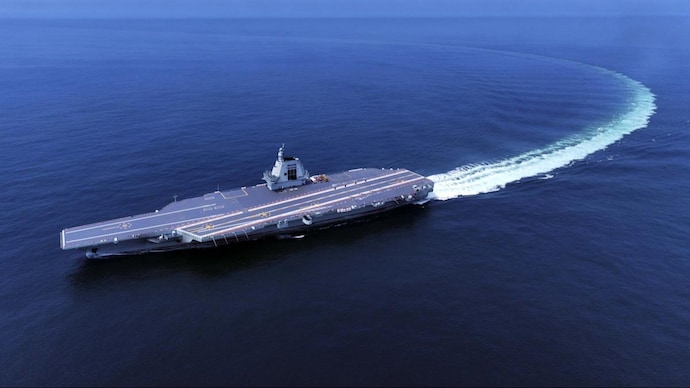- Views: 9K
- Replies: 61

The commencement of sea trials for China's colossal aircraft carrier, the Fujian, casts a spotlight on the evolving balance of power in the Indian Ocean Region.
This behemoth, displacing a staggering 80,000 metric tons, signifies China's ambitious naval modernization program. This Type-003 class warship ranks as the world's third-largest carrier, behind only by the U.S. Navy's Nimitz and Gerald R. Ford class giants. The Fujian serves as a potent symbol of China's strategic aspiration to become a dominant maritime power.
While China surges forward, India's plans for its next aircraft carrier, the IAC-2, remain stalled, awaiting crucial government approval. This disparity in pace underscores the differing strategic priorities between the two nations.
China's Rapid Naval Expansion
China's naval expansion has been nothing short of remarkable. In 2012, they commissioned their first aircraft carrier, the Liaoning, followed by the launch of the Shandong in 2019. This trajectory reflects China's audacious goal of possessing over 10 operational carriers by 2050.India's Naval Considerations
India, a pioneer in Asian carrier operations, acquired its first aircraft carrier, the HMS Hercules, from the United Kingdom in 1961. Today, the Indian Navy operates two carriers: the INS Vikramaditya (procured from Russia) and the recently commissioned INS Vikrant, India's first domestically built carrier (IAC-1).However, China's growing presence in the Indian Ocean Region necessitates that India strengthens its own naval capabilities. This urgency is further amplified by the delay in approving the IAC-2 program.
The IAC-2 and the Debate
The proposed IAC-2 would displace 45,000 tons and is estimated to cost approximately ₹40,000 crore (roughly $4.8 billion USD). This carrier, to be built by Cochin Shipyard Limited, would be modeled after the recently launched INS Vikrant.A key factor contributing to the delay in approving the IAC-2 is the ongoing debate within the Indian military establishment. This debate centers on the relative importance of aircraft carriers versus submarines in safeguarding India's maritime interests.
While submarines excel in covert operations aimed at denying the enemy the use of specific maritime areas, aircraft carriers provide crucial power projection and sea control capabilities.
Sea control involves the coordinated deployment of warships, aircraft, helicopters, and amphibious forces to maintain dominance over a particular maritime region.
The Formidable Fujian
The Fujian boasts several cutting-edge features, including an advanced Catapult Assisted Take-Off & Barrier Arrested Recovery (CATOBAR) system with an innovative electromagnetic aircraft launch system (EMALS).Launched in June 2022 from Shanghai's Jiangnan Shipyard, this 316-meter-long behemoth is expected to enter service in 2026.
With an estimated top speed of 31 knots and the capacity to accommodate 3,000 personnel, the Fujian is the largest aircraft carrier ever built outside the United States. It is powered by conventional steam turbines with diesel generators.
Looking Ahead
The upcoming sea trials of the Fujian are expected to span over a year, with a focus on evaluating the reliability of its propulsion and electrical systems.China plans to equip the carrier with upgraded versions of its J-15 fighter jets, alongside next-generation aircraft like the J-35 stealth fighter, the KJ-600 early warning aircraft, and the JL-10 advanced trainer jet.
India's wait for the IAC-2's approval creates a strategic quandary. As China's naval power surges, India faces growing pressure to expedite its own naval modernization efforts to maintain a credible maritime deterrent in the Indian Ocean Region.
